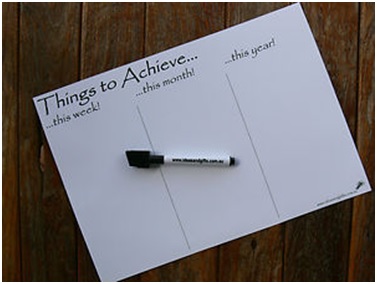To set a goal it has to be: S M A R T
A goal should provide guidance and direction. Goals like ‘lose weight’, ‘eat better’, or ‘get fit’ are far too vague and unspecific to help very much in making change. Use the S.M.A.R.T. criteria to help put more detail into your goal. Spending some time creating effective goals will be a huge help later on.
S – Specific:
This is the who, what, when, where, and how of your goal. To say I will exercise three times a week isn’t good enough, as too often people get to Saturday and realise they’ve yet to do anything, more specific the better.
For Example: Exercise at least 30 minutes a day, at least 3 days a week. Even better: “do at least 30 minutes of moderately intense cardio every Mon, Weds and Fri”.
M – Measurable:
You’ve got to be able to measure your goal in some way. Otherwise how will you know if you’ve reached it? “You can’t make what you can’t measure because you don’t know when you’ve got it made.” Dr Irving Gardner.
For Example:
– Set a new 5K/10K/marathon PR (personal record)
– Build up to being able to run for an hour
– Eat at least 5 servings of fruits and vegetables per day
A – Attainable:
If you really want to set yourself up for success, the goal should be something you can feasibly attain.
For Example: “train for and complete the Great South Run in November”. An unattainable goal would be aim to win that event (as amazing as that would be!!).
R – Realistic:
This is a little different from setting attainable goals. For example you might set yourself the attainable goal of a 32 inch waist in 3 months. That is certainly attainable if you are only a few inches away from your target. But when it comes to the methods you plan to use to achieve this goal, you might start to become unrealistic. “I will run every day”, “I will not eat any sweets, cakes or ice-cream for the next 3 months” are both examples of unrealistic methods that you have a slim chance of sticking to. Be realistic and ask yourself what the chances are that you will stick to any drastic change in behaviour.
T – Timely:
Your goal(s) should have a specific time-line; a date by which you want to achieve them. This will motivate you to get started, e.g. entering an event to train for.
This is probably one of the most important pieces. Without any sort of deadline, we don’t have any real motivation to make a change. I am pretty much the King of Procrastination. If I don’t give myself a specific date to start and a specific date to end, I will most likely put it off, especially if the change is hard, or the task is unpleasant.
Telling yourself you’re going to start exercising or you’re going to build up to run for an hour isn’t enough. When do you want to achieve this by? Next year? In two months? Having a goal will keep you motivated, and will also help you keep track of your progress.
For Example: Starting next week, I am going to do some form of cardio for at least 30 minutes, at least 3 days each week. I will to commit to this schedule for the next 3 months.
So you’ve sat down and set your goal, what else can you do? Commit to it, by either telling other people, or even better writing it down and displaying it, e.g. on fridge door. By publicising it, will make others aware so you will want to prove to them as well as yourself you can do it, and they can help offer encouragement on those days when you’re struggling. Track your progress; this will help keep motivating you. You can do this simply by keeping making a note in your diary, or even draw up a simple spreadsheet. Even better there are lots of websites and phone apps just for this, for example Strava, My Fitness Pal, Nike+ and Map My Fitness are all very good.
As winter draws in, with less light and more rain, we all need something to help keep us motivated. Setting a goal, or a series of short and long term goals, and even monitoring our progress will go a long way to helping keep all of us going. Setting SMART goals doesn’t mean you’ll never experience failure or setbacks. But it does give you something concrete to work toward and will increase your chances of being successful in 2013/14.
Providing adequate recovery is the key to progressing, and the truly smart way of managing your training to reach your final goal. Plan to reward yourself with non-food treats each time you achieve a mini-goal. The feeling of success can keep you motivated and on track. Second, non-food rewards help change behavioural patterns. Bottom line; remember that there are no quick fixes when it comes to fitness. Setting realistic goals, following the SMART program and making a genuine effort to attain your goal is a solid way to develop the healthy habits that will help you achieve long-term success.
Finally, one final footnote (forgive the pun):
The stress / recovery principle; says that you become fitter by subjecting your body to a stress, and then allowing recovery time before you stress it again. During the recovery time, the body rebuilds itself to be better able to handle that stress. In the case of running, this means that your heart, lungs and muscles become stronger and more efficient between running sessions. i.e. rest is just as important as training; you need to listen to what your body tells you. If you do pick up a niggle or injury, then err on the side of caution. The last thing you want to do is come back to quickly, injuries happen for a reason, usually due to over-training So allow plenty of time to recover then ease yourself back in.
If you don’t set a goal / target, then you’ll hit it every time!!









